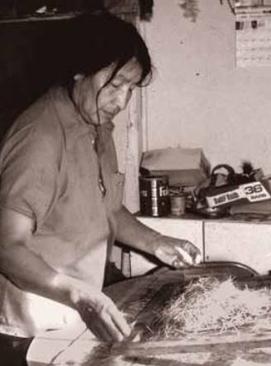Alice Blue Legs facts for kids
Quick facts for kids
Alice Blue Legs
|
|
|---|---|

1985, Alice Blue Legs by H. Jane Nauman
|
|
| Born |
Rosaline Alice New Holy
July 26, 1925 Pine Ridge Indian Reservation, Grass Creek, Shannon County, South Dakota
|
| Died | January 2, 2003 (aged 77) Rapid City, South Dakota
|
| Nationality | American |
| Other names | Alice New Holy Blue Legs |
| Occupation | craftsperson |
| Known for | quillwork |
Alice Blue Legs (born July 26, 1925 – died January 2, 2003) was a talented Lakota Sioux artist. She was famous for her amazing quillwork, a traditional art form. Alice Blue Legs received a special award, the National Heritage Fellowship, in 1985. This award is given to people who keep traditional arts alive.
Her beautiful quillwork was even featured in the famous movie Dances with Wolves. You can also see her art in museums like The Children's Museum of Indianapolis and the National Museum of the American Indian. Alice Blue Legs helped share the beauty of Lakota art with many people.
Early Life and Learning
Rosaline Alice New Holy was born on July 26, 1925. Her birthplace was the Pine Ridge Indian Reservation in South Dakota. Her parents were Julia and Joseph New Holy.
When Alice was 12, her mother passed away. Her father, his second wife, and her grandmother raised her. She went to the Oglala Community School and finished high school there.
Alice remembered her mother and grandmother, Quiver, doing traditional art. They made decorations and medallions. She learned some skills from her grandmother. However, both had died before Alice wanted to learn quillwork seriously.
Her father encouraged her to learn this traditional Lakota skill. He wouldn't touch the quills himself, as they were seen as women's tools. But he showed her designs in magazines. Alice taught herself the craft through practice and trying new things.
The Art of Quillwork
Quillwork is a special way of decorating using porcupine quills. To make designs, artists first collect the quills. Then, they boil and dye them in bright colors. After drying, the quills are ready to be used.
There are different ways to use the quills. For fringes and jewelry, quills are made soft and flat. This is often done by chewing them. Then, they are wrapped around strips of buckskin.
Another method is stitching. Here, quills are woven through flat fabrics. Alice Blue Legs mostly used these two methods. She rarely used a third method, which was for men's items like pipe stems. Her designs often copied old Lakota patterns. These patterns included both geometric shapes and free-flowing designs.
Sharing Her Talent
Alice became a skilled quiller before she married Amil Blue Legs. His family was known for hunting porcupines. Alice even taught Amil how to do quillwork.
Alice and Amil had five daughters, and she taught all of them how to quill. They lived in a log home that Amil built. They made money by creating crafts and clothing. These items included dresses, armbands, and jewelry.
Alice was worried that the art of quillwork might be forgotten. So, she taught many other Native craftspeople. She also held workshops at different places. These included Brown University, Dartmouth College, and The Children's Museum of Indianapolis.
Her work was shown in major museums that feature Native American art. These included the Heard Museum in Arizona. Her art was also part of a big exhibit in 1977. This exhibit, called Sacred Circles, showed 850 art pieces from many museums.
In 1985, Alice Blue Legs received the National Heritage Fellowship. This was the highest honor for craft workers from the National Endowment for the Arts. It recognized her efforts to keep traditional quillwork alive.
That same year, a film called Lakota Quillwork—Art and Legend was made about her family. The film showed women working with quills. It also showed how Alice, her husband, and daughters lived. It highlighted how their lives involved hunting, preparing, and working with quills.
Alice was also featured in celebrations for the South Dakota Centennial in 1987. Her quillwork was used in the movie Dances with Wolves in 1990. In 1993, she helped lead the Dakota Arts Congress. The documentary about her work won an award and was shown in Alaska in 2002.
Death and Legacy
Alice Blue Legs passed away on January 2, 2003, in Rapid City, South Dakota. She was buried in her family cemetery.
Her beautiful quillwork is kept in important collections. You can find her art at the United States Department of the Interior in Washington, D.C. Her work is also part of the permanent collection at the Smithsonian's National Museum of the American Indian. Alice Blue Legs left a lasting legacy through her art and her dedication to preserving Lakota traditions.

